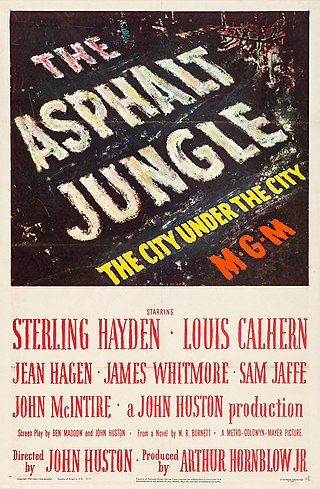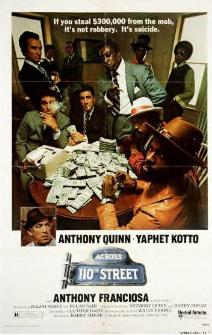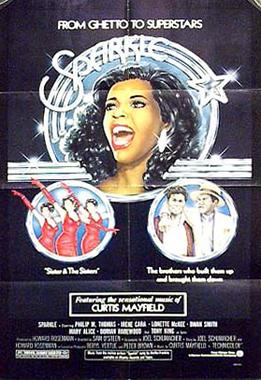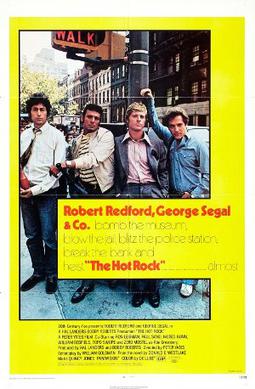
Ron O'Neal was an American actor, director and screenwriter, who rose to fame in his role as Youngblood Priest, a New York City cocaine dealer, in the blaxploitation film Super Fly (1972) and its sequel Super Fly T.N.T. (1973). O'Neal was also a director and writer for the sequel, and for the film Up Against the Wall.

The Asphalt Jungle is a 1950 American heist film noir directed and co-written by John Huston, and starring Sterling Hayden and Louis Calhern, with Jean Hagen, James Whitmore, Sam Jaffe, John McIntire, and Marilyn Monroe in one of her earliest roles. Based on the 1949 novel of the same name by W. R. Burnett, it tells the story of a jewel robbery in a Midwestern city.

Margaret Avery is an American actress. She began her career appearing on stage and later had starring roles in films including Cool Breeze (1972), Which Way Is Up? (1977), Scott Joplin (1977); which earned her an NAACP Image Award nomination, and The Fish That Saved Pittsburgh (1979). She was nominated for an Academy Award for Best Supporting Actress for her portrayal of Shug Avery in the period drama film The Color Purple (1985).
The heist film or caper film is a subgenre of crime films and the caper story, focused on the planning, execution, and aftermath of a significant robbery.

Across 110th Street is a 1972 American neo noir action thriller film directed by Barry Shear and starring Yaphet Kotto, Anthony Quinn, Anthony Franciosa and Paul Benjamin. The film is set in Harlem, New York and takes its name from 110th Street, the traditional dividing line between Harlem and Central Park that functioned as an informal boundary of race and class in 1970s New York City.

Shaft in Africa is a 1973 American blaxploitation film directed by John Guillermin, and the third film of the Shaft series, starring Richard Roundtree as John Shaft. Stirling Silliphant wrote the screenplay. The film's budget was $1.5 million, but the film was a box office flop, grossing just $1 million. Metro-Goldwyn-Mayer quickly sold the property to television, but the television series was cancelled after just seven episodes.

Sparkle is a 1976 American musical drama film directed by Sam O'Steen and released by Warner Bros. Pictures. With a plot inspired by the history of the Supremes, Sparkle is a period film set in Harlem, New York, during the late 1950s and early 1960s. It presents the story of a musical girl group that ends up breaking apart due to individual issues each member faces. This film not only "recreates the magic of a special period in American history, but it explores the effect of Harlem's musical and social culture on the rest of the world," as well as the linkages to black power.

Cleopatra Jones is a 1973 American blaxploitation film directed by Jack Starrett. Tamara Dobson stars as an undercover government agent who uses the day job of supermodel as her cover and an excuse to travel to exotic places. Bernie Casey, Shelley Winters and Antonio Fargas also feature. The film has been described as being primarily an action film, but also partially a comedy with a spoof tone.

Blacula is a 1972 American blaxploitation vampire horror film directed by William Crain. It stars William Marshall in the title role about an 18th-century African prince named Mamuwalde, who is turned into a vampire by Count Dracula in the Count's castle in Transylvania in the year 1780 after Dracula refuses to help Mamuwalde suppress the slave trade.

Willie Dynamite is a 1973 American blaxploitation film directed by Gilbert Moses and starring Roscoe Orman, Diana Sands, Thalmus Rasulala, Joyce Walker, and was released by Universal Pictures. The eponymous Willie Dynamite is a pimp in New York City, who strives to be number one in the city. As he is trying to do so, a social worker named Cora, is trying to change his ways - as well as those of the women who work for him - for the better. It was the first film produced by the Zanuck-Brown Company.

Thalmus Rasulala was an American actor with a long career in theater, television, and films. Noted for starring roles in blaxploitation films, he was also an original cast member of ABC's soap opera One Life to Live from its premiere in 1968 until he left the show in 1970.

The Hot Rock is a 1972 American crime comedy-drama film directed by Peter Yates and written by William Goldman, based on Donald E. Westlake's 1970 novel of the same name, which introduced his long-running John Dortmunder character. The film stars Robert Redford, George Segal, Ron Leibman, Paul Sand, Moses Gunn and Zero Mostel. It was released in the UK with the alternative title How to Steal a Diamond in Four Uneasy Lessons.

The Wiz is a 1978 American musical fantasy adventure film directed by Sidney Lumet. Adapted from the 1974 Broadway musical of the same name, the film reimagines the classic 1900 children's novel The Wonderful Wizard of Oz by L. Frank Baum with an African-American cast. Dorothy, a 24-year old teacher from Harlem, finds herself magically transported to the urban fantasy Land of Oz. On her travels seeking help from the mysterious Wiz, Dorothy befriends a Scarecrow, a Tin Man, and a Cowardly Lion.

Friday Foster is a 1975 American blaxploitation film directed by Arthur Marks and starring Pam Grier in the title role. Yaphet Kotto, Eartha Kitt, Scatman Crothers and Carl Weathers co-starred. It is an adaptation of the 1970–74 syndicated newspaper comic strip of the same name, scripted by Jim Lawrence and illustrated by Jorge Longarón. This was Grier's final film with American International Pictures. The tagline on the film's poster is "Wham! Bam! Here comes Pam!"

Blaxploitation is an ethnic subgenre of the exploitation film that emerged in the United States during the early 1970s, when the combined momentum of the civil rights movement, the Black power movement, and the Black Panthers spurred black artists to reclaim power over their image, and institutions like UCLA to provide financial assistance for students of color to study filmmaking. This combined with Hollywood adopting a less restrictive rating system in 1968. The term, a portmanteau of the words "black" and "exploitation", was coined in August 1972 by Junius Griffin, the president of the Beverly Hills–Hollywood NAACP branch. He claimed the genre was "proliferating offenses" to the black community in its perpetuation of stereotypes often involved in crime. After the race films of the 1940s and 1960s, the genre emerged as one of the first in which black characters and communities were protagonists, rather than sidekicks, supportive characters, or victims of brutality. The genre's inception coincides with the rethinking of race relations in the 1970s.
The Sophisticated Gents is a TV miniseries that aired on three consecutive nights from September 29 to October 1, 1981, on NBC. Its ensemble cast featured a number of African-American stage and film actors, many of whom were customarily seen in blaxploitation films in the 1970s. The miniseries is based upon the 1976 novel The Junior Bachelor Society by John A. Williams. Although production of the project ended in 1979, NBC did not air the miniseries until almost two years later.

Hit Man is a 1972 American crime film directed by George Armitage and starring Bernie Casey, Pam Grier and Lisa Moore. It is a blaxploitation-themed adaptation of Ted Lewis' 1970 novel Jack's Return Home, more famously adapted as Get Carter (1971), with the action relocated from England to the United States.

Trick Baby is a 1972 Blaxploitation film directed by Larry Yust and starring Kiel Martin and Mel Stewart. This crime-drama is based and named after a novel by Iceberg Slim written in 1967. The film was produced by Marshal Backlar and James Levitt. The film first premiered at the DeMille Theater, Seventh Avenue and 47th Street theatre, Juliet 2 Theater, and Third Avenue and 83 Street theatre in New York. This film is distributed by Universal Studios.
Blaxploitation horror films are a genre of horror films involving mostly black actors. In 1972 director William Crain did the first blaxploitation horror film, Blacula.
















